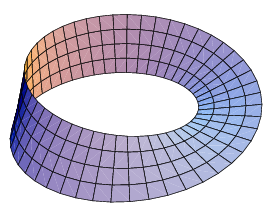Difference between revisions of "Mobius strip"
From Conservapedia
DavidB4-bot (Talk | contribs) (→top: Spelling, grammar, and general fixes) |
|||
| (4 intermediate revisions by 3 users not shown) | |||
| Line 1: | Line 1: | ||
| − | + | [[Image:Mobius.png|right|thumb|Graphical rendering of a Möbius strip]] | |
| − | + | A '''Möbius strip''' is a one-sided shape. It is formed by taking a thin strip of material, twisting a section 180 degrees, and making the two ends touch. Despite being one sided, the object does, in fact, still exist in three [[dimension]]s. | |
| − | [[ | + | If one is cut down the middle, the result is a strip with two twists; if this strip is cut down the middle, the result is two interlinked bands. |
| + | |||
| + | The shape was independently discovered by [[German]] [[mathematicians]] [[August Ferdinand Möbius]] and [[Johann Benedict Listing]]. | ||
| + | |||
| + | [[Topology|Topologically]], it is one of the two possible [[quotient]]s of a [[rectangle]]; the other is a [[torus]]. | ||
| + | |||
| + | [[Category:Geometry]] | ||
Latest revision as of 14:16, July 12, 2016
A Möbius strip is a one-sided shape. It is formed by taking a thin strip of material, twisting a section 180 degrees, and making the two ends touch. Despite being one sided, the object does, in fact, still exist in three dimensions.
If one is cut down the middle, the result is a strip with two twists; if this strip is cut down the middle, the result is two interlinked bands.
The shape was independently discovered by German mathematicians August Ferdinand Möbius and Johann Benedict Listing.
Topologically, it is one of the two possible quotients of a rectangle; the other is a torus.
